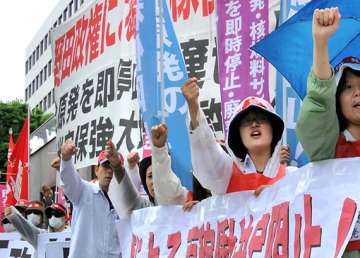Tokyo, Jun 20: The operator of the Japanese nuclear plant devastated by last year's tsunami issued a final report on the disaster Wednesday, outlining organizational and communication problems that have not yet been resolved.
The report by Tokyo Electric Power Co. comes as Japan prepares to restart its first nuclear reactors since the March 11, 2011, disaster led to a prolonged shutdown of all of the country's atomic generating plants.
While many Japanese remain deeply concerned about the safety of nuclear power, the restart raises operators' hopes that more reactors can resume operations.
The massive tsunami severely damaged four reactors at the Fukushima Dai-ichi nuclear plant north of Tokyo, knocking out cooling systems and triggering meltdowns and radiation leaks. Tens of thousands of people fled their homes in the worst atomic disaster since Chernobyl.
TEPCO Vice President Masao Yamazaki, who headed its probe of the disaster, acknowledged that the company had repeatedly underestimated the risk of a tsunami, despite predictions in recent years that such earthquake-generated waves could jump over seawalls protecting reactors.
Officials clung to optimistic views instead of taking the side of safety, he said.
“We must admit that our tsunami anticipation was too optimistic, and our insufficient preparations for a tsunami were the fundamental cause of the accident,” Yamazaki told a news conference.
Wednesday's report provided an incomplete picture of the accident because of the difficulty of inspecting the inside of the melted reactors. The company promised to make the best use of the findings to improve safety at its still-functional reactors, which it hopes to restart quickly as it struggles to finance astronomical compensation costs.
But it said the shortcomings disclosed in the report, both in hardware and crisis management, are still unresolved and need more improvement. It said further efforts are needed to foster flexibility among plant workers and establish a solid line of communication during crises.
Last week, the government approved the restart of two reactors belonging to another utility at the Ohi nuclear power plant in Fukui, western Japan, which will be the first to come back online since last year's disasters.
All 50 of Japan's commercial nuclear reactors have been offline for maintenance or safety checks. Public opposition has delayed their resumption of operations.
The government has pushed hard to bring some reactors online as soon as possible to avert power shortages during the high-demand summer months.
TEPCO has conducted “stress tests” at two of the seven reactors at its Kashiwazaki-Kariwa plant in Niigata in northern Japan, which are currently under review by the Nuclear and Industrial Safety Agency.
Yamazaki said TEPCO will rearrange key equipment, improve the water-tightness of reactor buildings and maintain backup cooling and water supply systems at the plant.
Latest World News
